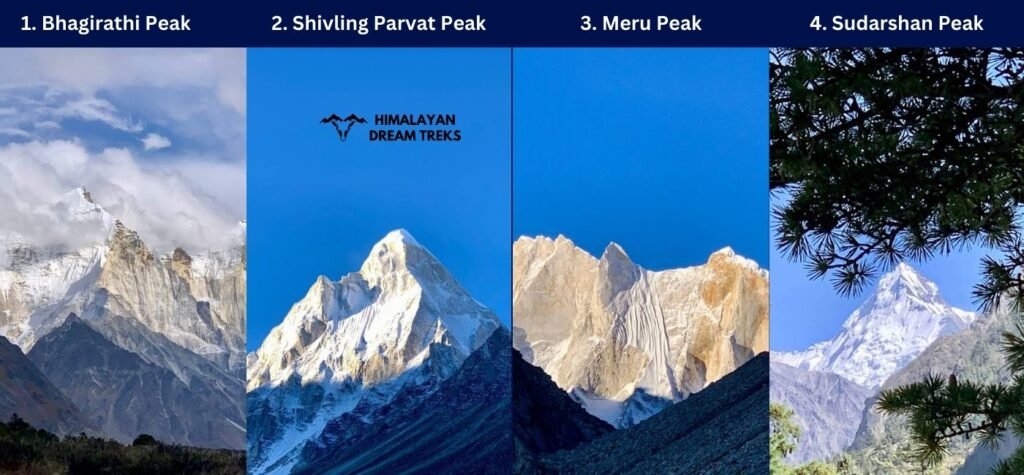In this blog, we’re diving deep into the wonders of Gaumukh and Tapovan. We’ll discuss what makes these places special and the fascinating history that renders them culturally rich!
What is Gaumukh?
Gaumukh, often referred to as Gomukhi, is situated in the Uttarkashi district of Uttarakhand, India. The name itself holds a unique charm, as “Gau” means cow, and “Mukh” translates to mouth, collectively resembling a cow’s mouth. This place marks the source of the Bhagirathi River, which is a crucial headstream of the mighty Ganges.
Situated at an elevation of 13,200 feet, Gaumukh is not just a point on the map; it’s the very birthplace of a sacred river, adding a spiritual touch to its significance. The journey to Gaumukh involves a trek of approximately 20 kilometers from Gangotri.
Beyond its geographical and spiritual significance, Gaumukh holds a unique aura, surrounded by beautiful landscapes and snow-capped peaks. Gaumukh is a symbol of purity and a source of life for the Ganges.
What is Gaumukh Tapovan?
Gaumukh Tapovan is again a spiritually significant location situated near Gaumukh. Combining the names “Gaumukh” and “Tapovan,” this region holds both natural beauty and spiritual significance.

Tapovan, derived from the Sanskrit words “tapas” meaning ‘spiritual practice,’ and “vana” meaning ‘forest’, collectively means the ‘forest of spiritual practice.’
Traditionally in India, any place where someone has undertaken serious spiritual retreats may be referred to as a tapovan, even if there is no actual forest. However, Gaumukh Tapovan specifically refers to the area adjacent to Gaumukh, combining Gaumukh with the spiritual vibes of Tapovan.
Gaumukh Tapovan is often visited by people for spiritual enlightenment. The region is known for its serene surroundings and spiritual energy that resonates throughout the area.
What is Gaumukh famous for?
The name “Gaumukh” finds its roots in ancient legends and Puranic tales. According to one such story, a young boy searching for a lost sheep stumbled upon a glacier in Gangotri. To his amazement, the glacier’s snout resembled a cow’s face, leading to the name of this natural wonder, “Gaumukh.”
Since this discovery, it’s been a favorite spot for saints, sages, sadhus, and anyone looking for a spiritual adventure. From this point, the Bhagirathi River emerges, and as it travels downstream, it joins the Alaknanda River at Devprayag to form the Ganga.
The religious importance of Gaumukh is immense. Many pilgrims, sadhus, saints, and spiritual seekers do this trek to witness the origin of the sacred river.
The trek is known for its challenging yet rewarding nature, offering breathtaking views of the Himalayas! The surroundings of Gaumukh are full of beautiful landscapes, towering peaks, and pristine glacial formations.
What is Tapovan famous for?
Tapovan, derived from Sanskrit, translates to the ‘forest of spiritual practice.’ The area is known for its spiritually charged atmosphere, attracting sadhus, saints, and spiritual seekers. The very name “Tapovan” signifies a place where individuals engage in rigorous spiritual practice. It is a haven for those seeking a quiet place to meditate and for other spiritual disciplines. Tapovan is often mentioned in various Hindu religious texts and scriptures, adding to its cultural and historical significance.
The place resonates with India’s spiritual traditions, attracting those interested in exploring the region’s cultural roots. Located in the Himalayan region, Tapovan offers breathtaking views of the surrounding mountains, including Shivling and Meru.
The region around Tapovan has been historically utilized by hermits (Tapasvi) for spiritual retreats. Over time, this has contributed to the area’s cultural heritage, with stories and traditions associated with the spiritual practices conducted in this serene environment.
Tapovan is also a famous destination for trekkers and astrophotography enthusiasts. Various treks like Nandanvan Vasuki Tal, and Kalindi Khal lie ahead of Tapovan. Tapovan is also the base camp for the Mt Shivling Expedition.
Which peaks can be seen from Tapovan?
Tapovan offers spectacular views of some of the majestic peaks in the Garhwal Himalayas and some of them are Shivling (one of the most prominent peaks visible from Tapovan and is known for its stunning pyramid shape), Meru Parbat (often associated with the Shark’s Fin route), the Bhagirathi peaks (including Bhagirathi I, II, and III), Sumeru Parvat and Kedardome (it has dome-like structure.)

Are Gaumukh and Gangotri the same? The Differences
Gaumukh and Gangotri are related geographical features in the Uttarkashi district of Uttarakhand, India, and might sound like siblings, but they’re not. Here are the key differences between Gaumukh and Gangotri:
| Gaumukh | Gangotri |
| Gaumukh is a specific glacial snout and the actual source of the Bhagirathi River, one of the primary headstreams of the Ganges. | Gangotri is a town located at a lower altitude than Gaumukh. It serves as the gateway to the Gangotri Glacier. |
| Gaumukh is where the Bhagirathi River originates. The Bhagirathi later merges with the Alaknanda River at Devprayag to form the Ganges. | Gangotri is the town where the Bhagirathi River is referred to as the Ganges for the first time. |
| Gaumukh is not easily accessible by road. It requires a trek of approximately 20 kilometres from Gangotri. | Gangotri is accessible by road and serves as the base camp for the trek to Gaumukh. |
Read More: Himalayan Dream Trek Conducted Marathon in Gaumukh.


Leave a Comment